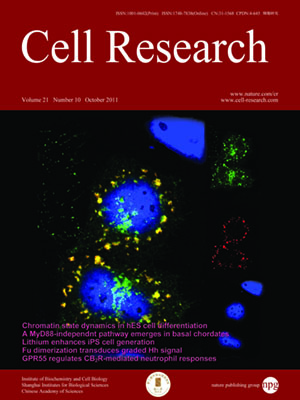
Volume 21, No 10, Oct 2011
ISSN: 1001-0602
EISSN: 1748-7838 2018
impact factor 17.848*
(Clarivate Analytics, 2019)
Volume 21 Issue 10, October 2011: 1452-1469
ORIGINAL ARTICLES
GPR55 regulates cannabinoid 2 receptor-mediated responses in human neutrophils
Nariman A B Balenga1, Elma Aflaki2, Julia Kargl1, Wolfgang Platzer1, Ralf Schröder3, Stefanie Blättermann3, Evi Kostenis3, Andrew J Brown4, Akos Heinema
1Institute of Experimental and Clinical Pharmacology, Medical University of Graz, Universit鋞splatz 4, Graz A-8010, Austria
2Institute of Molecular Biology and Biochemistry, Medical University of Graz, Graz, Austria
3Section Molecular, Cellular and Pharmacobiology, Institute for Pharmaceutical Biology, University of Bonn, Bonn, Germany
4Department of Screening and Compound Profiling, GlaxoSmithKline, Medicines Research Centre, Gunnels Wood Road, Stevenage, Hertfordshire, UK
Correspondence: Nariman A B Balenga, Maria Waldhoer,(nariman.balenga@medunigraz.at maria.waldhoer@medunigraz.at)
The directional migration of neutrophils towards inflammatory mediators, such as chemokines and cannabinoids, occurs via the activation of seven transmembrane G protein coupled receptors (7TM/GPCRs) and is a highly organized process. A crucial role for controlling neutrophil migration has been ascribed to the cannabinoid CB
2 receptor (CB
2R), but additional modulatory sites distinct from CB
2R have recently been suggested to impact CB
2R-mediated effector functions in neutrophils. Here, we provide evidence that the recently de-orphanized 7TM/GPCR GPR55 potently modulates CB
2R-mediated responses. We show that GPR55 is expressed in human blood neutrophils and its activation augments the migratory response towards the CB
2R agonist 2-arachidonoylglycerol (2-AG), while inhibiting neutrophil degranulation and reactive oxygen species (ROS) production. Using HEK293 and HL60 cell lines, along with primary neutrophils, we show that GPR55 and CB
2R interfere with each other's signaling pathways at the level of small GTPases, such as Rac2 and Cdc42. This ultimately leads to cellular polarization and efficient migration as well as abrogation of degranulation and ROS formation in neutrophils. Therefore, GPR55 limits the tissue-injuring inflammatory responses mediated by CB
2R, while it synergizes with CB
2R in recruiting neutrophils to sites of inflammation.
Cell Research (2011) 21:1452-1469. doi:10.1038/cr.2011.60; published online 5 April 2011
FULL TEXT | PDF
Browse 2034


